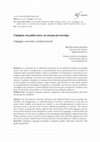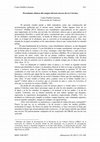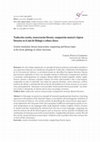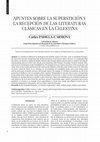Papers by Carlos PADILLA CARMONA
Roberto Baelo (ed.), II Foro de Innovación en la Internacionalización, 2024
Se estudian dos casos prácticos promovidos desde la UV, en los que internacionalización e innovac... more Se estudian dos casos prácticos promovidos desde la UV, en los que internacionalización e innovación van de la mano, y cuyo impacto repercute favorablemente a nivel universitario glocal (Robertson 1995). Ambas iniciativas cuentan con el respaldo de los vicerrectorados correspondientes, a través de sus Servicios: Servicio de Relaciones Internacionales y Cooperación y Servicio de Formación Permanente e Innovación Educativa.
Quaderns de filologia, Dec 20, 2023
La actividad consiste en identificar los tópicos literarios clásicos (previamente explicados en c... more La actividad consiste en identificar los tópicos literarios clásicos (previamente explicados en clase con ejemplos latinos) en diferentes composiciones poéticas o musicales contemporáneas en cualquier idioma objeto de estudio (español, catalán, inglés, francés, alemán o italiano) y después traducir los textos seleccionados a dos o más lenguas, respetando no solo el contenido, sino todos los aspectos formales, como estructura, métrica (número de sílabas y combinación del acento de intensidad con el ritmo musical, en su caso) y rima, principalmente. Llamamos a esta actividad "transcreación literaria (musical)". Los alumnos recitan o interpretan en directo ante la clase sus propias versiones.
Fortvnatae, Dec 31, 2022
hemos explorado su estilo, en el que, entre otros aspectos, como la elipsis, destaca la alteració... more hemos explorado su estilo, en el que, entre otros aspectos, como la elipsis, destaca la alteración del orden de palabras en la frase como un rasgo significativo. Esta alteración, que contrasta con las estructuras habituales SOV y «determinantedeterminado», emerge como un recurso crucial en su prosa. Nuestro enfoque intenta demostrar que las dislocaciones afectan por igual al significado y al significante, y obedecen, por tanto, a motivaciones expresivas o estéticas. Además, consideramos el contexto de cambio lingüístico de su época y las preferencias de Tácito por modelos distintos, enriqueciendo la comprensión de su estilo y de su legado literario y conectando con la evolución hacia las lenguas neolatinas. PALABRAS CLAVE: Tácito, Anales, estilo, inversión, disyunción, orden de palabras.

Quaderns de Filologia - Estudis Lingüístics, 2021
La ocultación de los referentes femeninos en los diferentes ámbitos de prestigio social y, por ta... more La ocultación de los referentes femeninos en los diferentes ámbitos de prestigio social y, por tanto, la desaparición o minusvaloración de las aportaciones de las mujeres en cualquier espacio de poder donde se valore la visibilidad y la notoriedad es un fenómeno muy antiguo al que nadie le había puesto nombre hasta ahora, pero que hemos sufrido sistemáticamente como sociedades. Los autores han creado un concepto que, de forma clara, muestra esta carencia. La palabra criptoginia se compone de dos elementos griegos fácilmente identificables en otras palabras de nuestras lenguas: crypto (ocultar) y gyné (mujer). En este trabajo, además de la argumentación etimológica y lingüística, se presentan una serie de razones culturales y sociológicas que justifican la oportunidad del nuevo término para, finalmente, establecer unas líneas de actuación enmarcadas en la articulación de una propuesta didáctica.
L'empremta catalana al Corbacho de Martínez de Toledo
The author –quite probably the authors- of La Celestina was not unaware of the literary Classical... more The author –quite probably the authors- of La Celestina was not unaware of the literary Classical tradition: besides the influence of the Roman comedy, it must be uderlined that of the Senecan thought, especially in Act I. KEYWORDS: La Celestina, Roman Comedy, Senecan thought.

Llull, Cervantes, Shakespeare: Imágenes literarias de la locura
espanolEn el ano 2016 coincidieron los centenarios de la muerte de Ramon Llull, Miguel de Cervant... more espanolEn el ano 2016 coincidieron los centenarios de la muerte de Ramon Llull, Miguel de Cervantes y William Shakespeare. Septimo centenario en el caso del escritor mallorquin y cuarto para el castellano y el ingles. Este libro es un homenaje a estos tres escritores, cuya influencia sigue siendo paradigmatica en nuestro mundo. Los tres se han considerado siempre testimonios cimeros de las literaturas catalana, castellana e inglesa, respectivamente, y que en su dia realizaron un papel fundamental en la formacion del estandar culto de sus lenguas. El tema de la locura, sus imagenes literarias, los personajes locos o falsos locos, etc. son recurrentes en los tres autores y son el hilo conductor de este libro. catalaL'any 2016 van coincidir els centenaris de la mort de Ramon Llull, Miguel de Cervantes i William Shakespeare. Sete centenari en el cas de l'escriptor mallorqui i quart per al castella i l'angles. Aquest llibre es un homenatge a aquests tres escriptors, la influe...
La entidad fonética y fonológica de H y su integración en el sistema de oclusivas y fricativas indoeuropeas: revisión etimológica de algunos téminos latinos
Studia Philologica Valentina, 2012
Coordinació i subordinació En molts aspectes de la sintaxi llatina hi ha un cert consens terminol... more Coordinació i subordinació En molts aspectes de la sintaxi llatina hi ha un cert consens terminològic. La diferència entre coordinació i subordinació no ha estat pràcticament qüestionada durant decennis, 2 encara que alguns
Esbozo de una teoría psicolingüística en Juan Luis Vives
Congreso Internacional Sobre Humanismo Y Renacimiento Vol 2 1998 Isbn 84 7719 675 3 Pags 535 540, 1998
Reconstrucción del sistema primitivo de oclusivas y fricativas en indoeuropeo: a propósito de *dek-"mano
La connotación y la especialización semántica en la prosa de L. A. Séneca: un ejemplo: el campo léxico de los viajes
Studia Philologica Valentina, 1997
Tratamiento en latín de laringal en posición inicial
Nova Et Vetera Nuevos Horizontes De La Filologia Latina Vol 1 2002 Isbn 84 930825 4 6 Pags 281 288, 2002
La fecha de composición del De breuitate uitae
Séneca, dos mil años después: actas del …, 1997
Localización: Séneca, dos mil años después: actas del Congreso Internacional del Bimilenario de s... more Localización: Séneca, dos mil años después: actas del Congreso Internacional del Bimilenario de su nacimiento:(Córdoba, 24 a 27 de septiembre de 1996)/coord. por Miguel Rodríguez-Pantoja Márquez, 1997, ISBN 84-7959-185-4, págs. 379-386

ehumanista Journal of Iberian Studies, 2017
espanolTradicionalmente se ha relacionado el conjuro del acto tercero de La Celestina con otros m... more espanolTradicionalmente se ha relacionado el conjuro del acto tercero de La Celestina con otros muy similares encontrados en Juan de Mena (Laberinto de Fortuna (247-252, vv. 1969-1984) y Lucano (Farsalia VI, 667-718). La opinion comun es que Rojas se inspiro en Mena y este, a su vez, habia tomado como modelo a Lucano. Ambos casos se refieren a la formula ritual del conjuro, pero no al objeto magico empleado: un hilado. En nuestro estudio presentamos un nuevo referente (Petronio, Satiricon 131) en el que aparece un hilado, tambien aportado por una vieja hechicera, utilizado como elemento magico para fines amatorios. Los hilados de diferente tipo se han utilizado confines magicos desde tiempos prehistoricos. Palabras clave: Celestina, conjuro, hilado, cordon, Petronio, Satiricon. EnglishTraditionally the spell of the third act of La Celestinahas been related to very similar ones found in Juan de Mena (Laberinto de Fortuna (247-252, vv. 1969-1984), and Lucanus (Pharsalia VI, 667-718). ...

Quaderns de Filologia. Estudis Literaris, 2023
En este trabajo exponemos un ejemplo de buenas prácticas innovadoras basado en una experiencia do... more En este trabajo exponemos un ejemplo de buenas prácticas innovadoras basado en una experiencia docente con estudiantes del grado de Traducción y Mediación Interlingüística de la Universitat de València. La actividad consiste en identificar los tópicos literarios clásicos (previamente explicados en clase con ejemplos latinos) en diferentes composiciones poéticas o musicales contemporáneas en cualquier idioma objeto de estudio (español, catalán, inglés, francés, alemán o italiano) y después traducir los textos seleccionados a dos o más lenguas, respetando no solo el contenido, sino todos los aspectos formales, como estructura, métrica (número de sílabas y combinación del acento de intensidad con el ritmo musical, en su caso) y rima, principalmente. Llamamos a esta actividad “transcreación literaria (musical)”. Los alumnos recitan o interpretan en directo ante la clase sus propias versiones.
Palabras clave: traducción creativa; transcreación; composición musical; tópicos literarios.
Abstract: In this paper we present an example of innovative good practices based on a teaching experience with students of the Bachelor Degree in translation and interlinguistic mediation of the University of Valencia. The activity consists of identifying the classic literary topics (previously explained in the classroom with Latin examples) in different contemporary poetic or musical compositions in any language under study (Spanish, Catalan, English, French, German or Italian) and later translating the selected texts into two or more languages, respecting not only the content, but all the formal aspects such as structure, metrics (number of syllables and combination of intensity accent with musical rhythm, if applicable) and rhyme, mainly. We call this activity ‘(musical) literary transcreation’. Students recite or perform their own versions live in front of their classmates.
Keywords: creative translation; transcreation; songwriting; literary topics.
FORTUNATAE, 2023
En nuestro análisis de la obra de Tácito, hemos explorado su estilo, en el que, entre otros aspec... more En nuestro análisis de la obra de Tácito, hemos explorado su estilo, en el que, entre otros aspectos, como la elipsis, destaca la alteración del orden de palabras en la frase como un rasgo significativo. Esta alteración, que contrasta con las estructuras habituales SOV y «determinante / determinado», emerge como un recurso crucial en su prosa. Nuestro enfoque intenta demostrar que las dislocaciones afectan por igual al significado y al significante, y obedecen por igual a motivaciones expresivas o estéticas. Además, consideramos el contexto de cambio lingüístico de su época y las preferencias de Tácito por modelos distintos, enriqueciendo la comprensión de su estilo y de su legado literario y conectando con la evolución hacia las lenguas neolatinas. PALABRAS CLAVE: Tácito, Anales, estilo, inversión, disyunción, orden de palabras.

Transilvania, 2023
La Celestina está influida por aspectos ideológicos y estéticos de su época, como la literatura m... more La Celestina está influida por aspectos ideológicos y estéticos de su época, como la literatura moralizante, las nuevas corrientes líricas llegadas de Italia y la aparición de géneros literarios nuevos. Sin embargo, se destaca que el autor conocía directa o indirectamente a los principales autores clásicos y se vale de ellos para reforzar el carácter didáctico y moralizante de la obra. Ya al inicio del Prólogo se mencionan las sentencias de Heráclito, Petrarca, Aristóteles, Plinio y Lucano para destacar cómo las luchas entre amos y esclavos, entre el placer y la virtud, entre el mundo terrenal y el celestial vertebran el argumento de la obra. En este contexto, el cultivo de la hechicería no puede estar ausente. En La Celestina, se observan técnicas de magia simpática, como la del nomen omen y la posesión de la voluntad de otra persona a través de objetos. El pasaje del conjuro de Celestina, así como la posesión del cordón de Melibea, son ejemplos de ello. Las Metamorfosis de Apuleyo, pudieron ser una fuente de inspiración para el autor de la Tragicomedia. Junto con las técnicas de brujería, observamos en la obra una tergiversación casi paródica del discurso cristiano para justificar determinados comportamientos. La magia y los hechizos eran considerados peligrosos y relacionados con el diablo y la brujería, y aquellos acusados de practicar magia podían ser perseguidos y castigados severamente. La Celestina es un ejemplo de cómo se utiliza la superstición en sentido amplio (magia y religión) para dar una explicación irracional a los fenómenos, como la obsesión amorosa de Calisto.
Studia Philologica Valentina, 2022
Resumen: Los Diálogos sexto, undécimo y duodécimo de Séneca recogen, respectivamente, sus Consola... more Resumen: Los Diálogos sexto, undécimo y duodécimo de Séneca recogen, respectivamente, sus Consolaciones a Marcia, a Polibio y a su madre Helvia. El filósofo las aprovecha para exponer sus teorías estoicas sobre la irreversibilidad de la muerte y la inutilidad del lamento. Con tres destinatarios diferentes, pero con argumentos, estructura y estilo semejantes, las Consolaciones nos permiten ahondar en el pensamiento senequiano. De ellas, Ad Helviam es, sin duda, la más personal e íntima y nos ofrece numerosas pistas que nos hacen pensar que el propio Séneca utilizaba la escritura como método catártico para mitigar su propio dolor.










Uploads
Papers by Carlos PADILLA CARMONA
Palabras clave: traducción creativa; transcreación; composición musical; tópicos literarios.
Abstract: In this paper we present an example of innovative good practices based on a teaching experience with students of the Bachelor Degree in translation and interlinguistic mediation of the University of Valencia. The activity consists of identifying the classic literary topics (previously explained in the classroom with Latin examples) in different contemporary poetic or musical compositions in any language under study (Spanish, Catalan, English, French, German or Italian) and later translating the selected texts into two or more languages, respecting not only the content, but all the formal aspects such as structure, metrics (number of syllables and combination of intensity accent with musical rhythm, if applicable) and rhyme, mainly. We call this activity ‘(musical) literary transcreation’. Students recite or perform their own versions live in front of their classmates.
Keywords: creative translation; transcreation; songwriting; literary topics.
Palabras clave: traducción creativa; transcreación; composición musical; tópicos literarios.
Abstract: In this paper we present an example of innovative good practices based on a teaching experience with students of the Bachelor Degree in translation and interlinguistic mediation of the University of Valencia. The activity consists of identifying the classic literary topics (previously explained in the classroom with Latin examples) in different contemporary poetic or musical compositions in any language under study (Spanish, Catalan, English, French, German or Italian) and later translating the selected texts into two or more languages, respecting not only the content, but all the formal aspects such as structure, metrics (number of syllables and combination of intensity accent with musical rhythm, if applicable) and rhyme, mainly. We call this activity ‘(musical) literary transcreation’. Students recite or perform their own versions live in front of their classmates.
Keywords: creative translation; transcreation; songwriting; literary topics.